
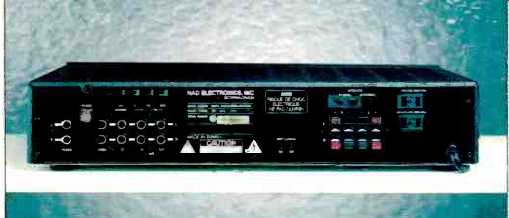
Manufacturer's Specifications:
FM Section:
Usable Sensitivity: Mono. 10.8 dBf.
50-dB Quieting: Mono, 14.4 dBf; stereo, 37 dBf.
S/N: Mono, 80 dB; stereo, 74 dB.
THD: Mono, 0.1% at 1 kHz, 0.2% at 100 Hz and 6 kHz; stereo, 0.1% at 1 kHz, 0.3% at 100 Hz and 6 kHz.
Frequency Response: 30 Hz to 15 kHz, ±0.5 dB.
Capture Ratio: 1.5 dB.
Selectivity: 58 dB.
AM Rejection: 60 dB.
Image Rejection: 70 dB.
l.f. Rejection: 90 dB.
Subcarrier Rejection: 60 dB.
SCA Rejection: 60 dB.
Stereo Separation: 45 dB.
AM Section:
Usable Sensitivity: 5 µV.
S/N: 45 dB.
THD: 0.5%.
Selectivity: 30 dB.
Image Rejection: 45 dB.
I.f. Rejection: 35 dB.
Amp and Preamp Section:
Power Output: 20 watts per channel, 20 Hz to 20 kHz, 8-ohm loads.
Rated THD: 0.04%.
Dynamic Headroom: 4.4 dB at 8 ohms.
Clipping Power, 1 kHz: 25 watts per channel at 8 ohms.
Dynamic Power Per Channel (Short Term): 55 watts at 8 ohms, 75 watts at 4 ohms, 85 watts at 2 ohms.
Damping Factor: Greater than 30 at 8 ohms 50 Hz.
SMPTE IM: Less than 0.04%.
CCIF IM, IHF IM, and TIM: Less than 0.04%.
Input Sensitivity for 1 Watt Output: Phono, 0.55 mV; high level, 33 mV.
S/N (A-Weighted): Phono, 75 dB re: 5 mV input; high level, 84 dB re: 1 watt output.
Phono Overload: 200 mV at 1 kHz, 20 mV at 20 Hz, 1,700 mV at 20 kHz.
RIAA Accuracy: ±0.5 dB.
Frequency Response: High level, 20 Hz to 20 kHz. +0.5,-1.0 dB.
Tone-Control Range: Bass, ± 10 dB at 50 Hz; treble, ±7 dB at 10 kHz.
Infrasonic Filter: -3.0 dB at 15 Hz, 24 dB/octave.
General Specifications:
Power Consumption: 120 V, 50/60 Hz a.c., 150 watts.
Dimensions: 16 1/2 in. W x 3 3/8 in. H x 10 3/4 in. D (42 cm x 8.6 cm x 27.3 cm).
Weight: 12.1 lbs. (5.5 kg).
Price: $278.
Company Address: 575 University Ave., Norwood, Mass. 02062, USA.
NAD has always eschewed the bells, lights, and whistles approach to audio product design. Judging from its front panel, the 7220PE might well be characterized as the "plain Jane" of stereo receivers. Yet, when you look behind that rather drab front and begin to explore its innovative circuit design, solid construction, and consistently high-quality performance, you can't help but wonder how NAD is able to market this receiver at such a low, low price.
Circuit Description
Since circuit innovation is what makes this an outstanding performer, let's discuss that first. To begin with, don't be put off by the low continuous power rating of 20 watts per channel into 8-ohm loads. NAD had to specify that low power level to conform with FTC rules, but I know I don't listen to continuous steady-state tones and I'll bet you don't either. In the real world of musical listening, the 7220PE's unusual power supply, the heart of what NAD calls their Power Envelope circuit, can deliver short-term peaks that are 4.4 dB greater than the nominal continuous power rating. That would bring the total up to about 55 watts per channel. In fact, my measurements of dynamic headroom were even a bit better: 4.8 dB. In terms of power, that works out to be just a shade over 60 watts per channel!

The 7220PE's interior (above) is uncluttered, and its rear panel (see top of
page) includes two unusual switches (see text).
Another feature of the receiver prompted me to reminisce about the time when vacuum tubes and output transformers were used in all audio amplifiers. In those days, the secondary windings of output transformers had taps at different impedances so that optimum impedance matches could be obtained for speaker loads of 4, 8, or 16 ohms. In somewhat similar fashion, NAD has provided an impedance switch on this receiver. In its 8-ohm position, maximum output voltage is provided for loudspeakers of 8 ohms or higher. In its alternate, 4-ohm setting, voltage is lowered but current capacity is correspondingly increased to allow driving lower impedance speakers or two pairs of speakers wired in parallel.
A "soft-clipping" circuit developed by NAD, when switched on, gently limits the waveform if the output transistors are driven into saturation. Those who believe "tube sound" is superior to "solid-state sound" will appreciate this feature-especially if they tend to play music at loud levels that might exceed the amplifier's short-term power output capacity.
Another enhancement found in the 7220PE is an infrasonic filter. Unlike most built-in subsonic "rumble" filters that have a shallow roll-off characteristic of 6 dB/octave, this one has a 24-dB/octave slope with a cutoff point of 15 Hz. This receiver employs frequency-synthesis tuning, and the FM front-end uses a dual-gate MOS-FET which provides adequate sensitivity while resisting overload or cross-modulation distortion at high signal levels.
Control Layout
At the left of the matte black front panel is a green "Power" button, with a stereo headphone jack immediately to its right. A button labeled "Extra Speakers" follows.
NAD's approach here is to give the user only the option of turning a second set of speakers on and off-the system's primary speakers are always on. The owner's manual offers tips on how to connect a second set of speakers for "ambience recovery," should you want that kind of sound enhancement; of course, the second set of speakers can also be wired in the conventional manner for use as a stereo pair in another room. "Bass," "Treble," and channel "Balance" knobs, each with a center detent position, come next. After these are a "Tape Monitor" button (only one tape monitor loop is provided) and a cluster of five matching input selector buttons. In keeping with current trends, the two high level inputs are identified as "CD" and "Video." These, of course, are nothing more than extra high-level audio inputs which can be used for any stereo program source you wish.
The next pair of pushbuttons are for mono/stereo switching and turning on loudness compensation. A large rotary "Volume" control knob is at the extreme right of the panel; just above it is a momentary rocker switch for up and down tuning.
The upper center section of the panel houses the frequency display, five station preset buttons, "FM Stereo" and "Center Tune" indicator LEDs, an "Enter" button for memorizing up to five FM and five AM station frequencies, and a "Search" button. When "Search" is in its depressed position, touching the tuning bar causes the tuner to seek the next usable FM or AM signal.
As ergonomically ideal as the front panel of this receiver seems to be, it's clear that somebody wasn't thinking as carefully when they designed the back panel. The antenna terminals are, in my opinion, both poorly labeled and poorly configured. If your FM antenna's 300-ohm twin lead comes with handy spade lugs, you'll have to cut them off and strip the wires to feed them into the spring-loaded terminals provided for antenna connection. In all fairness to NAD, I should mention that the supplied twin-lead dipole antenna does have its leads stripped back at the connection point, so you won't need to use any tools if you choose to use it.
Still, you'll have to be careful when you connect its two wires: One of them should go to the terminal for 300 ohms and the other to the adjacent terminal for 75 ohms-not to the terminal marked "G" for ground. On the other hand, if your FM antenna has a 75-ohm coaxial line, you'll have to cut off the standard F-type connector. Then you'll have to strip back and braid the cable's outer shield and strip some insulation from the inner conductor to fit into the 75-ohm and ground terminals. If you want to listen to AM, you must connect a wire to the "AM Antenna" terminal, as there is no built-in antenna. NAD does provide a length of wire for this purpose (which, in most instances, is all you'll need), but the omission of the usual loopstick is unusual.
The phono input jacks are at the extreme left end of the rear panel, with a ground terminal conveniently located nearby. The remaining sets of input jacks and tape output jacks are beneath the antenna terminals. Farther to the right are the "Soft Clipping" switch, two color-coded sets of spring-loaded speaker terminals (not unlike the antenna terminals), the previously discussed "Impedance" switch, and convenience a.c. receptacles (one switched and one unswitched).
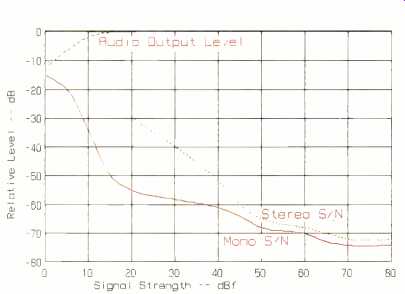
Fig. 1-Mono and stereo quieting characteristics, FM section.
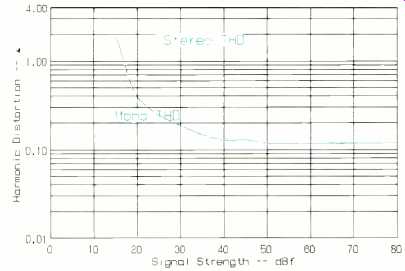
Fig. 2-Mono and stereo THD characteristics, FM section, at 1 kHz.
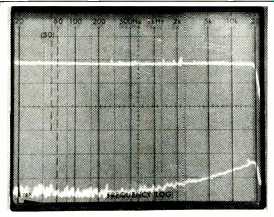
Fig. 3-FM frequency response (top trace) and separation vs. frequency (bottom
trace).
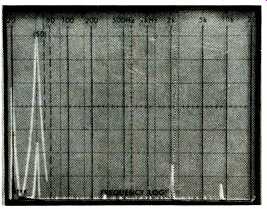
Fig. 4-Separation and crosstalk components for a 5-kHz FM modulating signal.
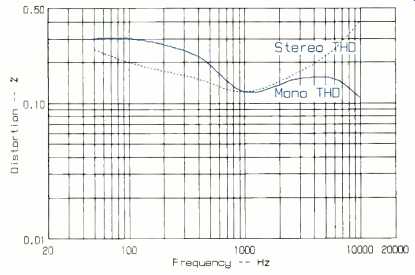
Fig. 5-THD vs. frequency, FM section.
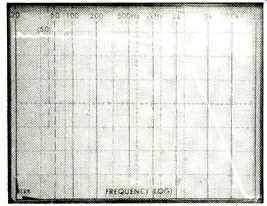
Fig. 6--AM frequency response.
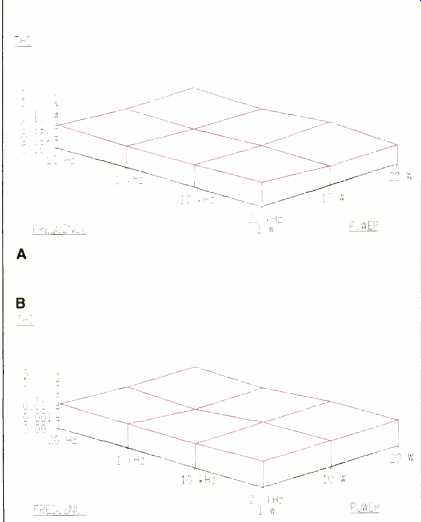
Fig. 7--THD vs. frequency for three power levels, with 8-ohm load (A) and
4-ohm load (B).
Tuner Measurements
Mono usable FM sensitivity measured 11.0 dBf, very close to the 10.8 dBf claimed by NAD. Stereo usable sensitivity, not specified by NAD, was 20 dBf. Signal-to-noise ratios for strong input signals, as seen in Fig. 1, fell some what short of NAD's claims, measuring 74 dB in mono and 72 dB in stereo. Figure 2 shows how THD varied with increasing signal strength. At 65 dBf, both mono and stereo THD at 1 kHz measured 0.12%, just slightly higher than the 0.1% specified.
The tuner's FM frequency response and stereo separation are shown in Fig. 3. Response (top trace) was excellent, deviating by a mere -0.2 dB at the low frequency extreme and by an insignificant 0.1 dB at 15 kHz, where most FM tuner sections exhibit roll-offs-as much as 2 or 3 dB in some cases. Separation (bottom trace) at 1 kHz was nearly 50 dB; at 100 Hz and 10 kHz, separation remained a more than adequate 45 and 43 dB, respectively.
Figure 4 shows what was present at the receiver's left and right outputs when a 5-kHz signal was used to modulate only one channel of the FM tuner's input signal. The difference in height between the tall spike at the left and the shorter one within it represents separation, about 45 dB.
(The vertical scale is 10 dB per division.) The components at the extreme right of the photo are sidebands surrounding the suppressed 38-kHz subcarrier. Note that, at least within the 70-dB dynamic range of this analysis, there is evidence neither of any 19-kHz residual pilot signal nor of any other distortion components at the output of the unmodulated channel. All of this speaks well for the FM tuner's phase linearity and the effectiveness of its multiplex decoder.
Figure 5 shows how distortion varied with frequency for strong FM signals in mono and stereo. Below 900 Hz or so, stereo THD was actually a bit lower than mono THD, but this situation was reversed at higher frequencies.
Capture ratio was 1.8 dB. AM rejection was surprisingly high, almost exactly the claimed 60 dB. I.f. and SCA rejection, at 90 and 60 dB, met specification. My measurements of selectivity (62 dB) and image rejection (75 dB) were somewhat higher than the claimed values (by 4 and 5 dB, respectively). Subcarrier rejection, 70 dB, was far better than claimed, a full 10 dB greater than NAD's spec. Spurious-response rejection, not specified by the manufacturer, was 85 dB. No interstation muting is provided on this tuner; stereo threshold was 20 dBf.
The high-frequency response of the AM tuner section was not significantly better than that of most receivers' AM sections. Still, it must be said that over the useful range of response that was provided (up to around 3.0 kHz), response was very uniform, as shown in Fig. 6. Many AM tuner sections I've tested in the past have tended to roll off both the bass and the treble; this one maintained good bass response down to 20 Hz.
Amplifier Measurements
The amplifier section of the 7220PE produced 30.8 watts of continuous power per channel at mid-frequencies into 8-ohm loads. At 20 Hz, maximum continuous power for the rated THD of 0.04% was 26 watts; at 20 kHz, the amplifier delivered 30 watts per channel for the same THD level. The "three-dimensional" plot of Fig. 7A shows how distortion varied with power output at four different test frequencies: 20 Hz, 1 kHz, 10 kHz, and 20 kHz. At rated power output (20 watts per channel, continuous), THD was a mere 0.0035% at 1 kHz, 0.0045% at 20 Hz, and 0.019% at 20 kHz. SMPTE IM distortion measured only 0.006% at rated output. Using a reference power level of 20 watts per channel, dynamic headroom for 8-ohm operation measured an amazingly high 4.8 dB, thanks to NAD's unique Power Envelope design.
Damping factor at 8 ohms, using a 50-Hz test signal, measured 56 as against NAD's minimum claim of 30.
NAD does not provide a continuous power rating for 4-ohm operation. Nevertheless, I measured this parameter in much the same way that I did for 8 ohms. Results for the four major test frequencies are plotted in Fig. 7B. I should note that these measurements were made with the receiver's impedance selector switch in the 4-ohm position. Just out of curiosity, I checked to see how much power would be delivered into 4-ohm loads if the switch were left in the "wrong" (8-ohm) position. For 0.04% THD, the amplifier delivered an amazingly high 68 watts per channel at 1 kHz when the switch was properly set, as against only 41.6 watts per channel when the switch was improperly set. At the frequency extremes, the differences were not as great. The amplifier produced 38 watts at 20 Hz and 45.5 watts at 20 kHz with the impedance switch properly set to 4 ohms; with the switch set to 8 ohms and the amplifier still connected to 4-ohm loads, maximum output at 20 Hz and 20 kHz measured 33 watts and 39 watts, respectively. In any case, it's very clear that this impedance switch does optimize the match between the output stages of the receiver and the load for maximum undistorted power transfer. Assuming an arbitrary continuous power rating of 35 watts per channel into 4-ohm loads, dynamic headroom measured 3.5 dB.
This means that for peaks of short duration, as much as 78 watts per channel is delivered-actually a bit more than the 75-watt "Dynamic Power" specification published by NAD for these operating conditions.
Figure 8, a plot of the boost and cut range of the bass and treble controls, illustrates yet another well-designed feature of the amplifier/preamplifier section. Notice that in the mid range-from around 200 Hz to about 3 kHz-there is practically no tone-control action even when the bass and treble controls are rotated fully clockwise and counterclockwise (as they were for this test). This type of tone-control action will allow you to vary the strength of the bass and the crispness of the treble detail without changing the overall timbre of a singer's voice or the sound balance of solo instruments. Such would not be the case if the tone controls had their turnover or pivot points smack in the midrange area between 500 Hz and 2 kHz, as so many tone-control circuits do.
Loudness compensation, plotted for various volume set tings in Fig. 9, was very moderate, imparting no more than about 5 or 6 dB of bass boost and less than 3 dB of treble emphasis at low listening levels. Overall frequency response from the high-level inputs to the speaker outputs was flat to within -1.0 dB from 17 Hz to 35 kHz. The-3 dB point occurred exactly at 15 Hz, as determined by the built in subsonic filter, while high-end roll-off reached-3 dB at 50 kHz. Phono frequency response conformed closely to the RIAA playback characteristic with absolutely no deviation above 400 Hz and with a maximum deviation of only +0.3 dB at 30 Hz.
Input sensitivity for the phono section, for 1 watt output, measured 0.55 mV, while the high-level inputs required 30 mV of signal to produce 1 watt output into 8-ohm loads.
Phono overload for a 1-kHz input signal measured 225 mV, well above the already impressively high 200 mV claimed by NAD. Phono and high-level hum and noise were identical, a notably high 81 dB below 1 watt output. At minimum volume, residual noise was 94 dB below 1 watt.
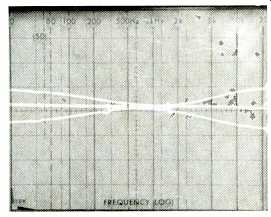
Fig. 8--Tone-control range; see text.
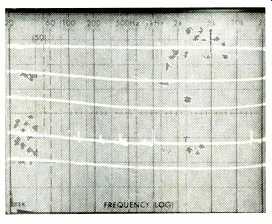
Fig. 9--Loudness-control characteristics at various volume settings.
Use and Listening Tests
The advantages of the Power Envelope design (large dynamic headroom) became immediately apparent when I hooked up the 7220PE to my low-efficiency reference speakers. While in truth I wasn't able to develop nearly as much sound power as I normally get when these speakers are hooked up to my reference (200 watt/channel) amplifier, the clean loudness levels that I did achieve were far more than I would ever have expected from a receiver whose "official" continuous power rating is only 20 watts per channel. In fact, when I substituted a somewhat more efficient pair of speakers that have a sensitivity rating of around 89 dB per watt at 1 meter, I was able to get as much SPL as I would reasonably ever want. Normally, these same speakers have required amplifiers whose power ratings were at least in the range of 60 to 75 watts. At all listening levels below clipping, I found the sound to be well balanced and reasonably transparent. With the receiver's soft-clipping switch turned on, even moderate amounts of overload seemed tolerable.
I missed having some sort of signal-strength indicator for the FM tuner section, but I did find that the center-tune indicator was completely accurate. I think you will appreciate the fact that the 7220PE's FM section tunes in increments of only 50 kHz. This will be useful if you pick up FM signals from a cable TV system which carries them at nonstandard frequencies. It may also prove helpful in dealing with adjacent-channel interference; if the desired signal is strong enough, off-tuning the set by 50 kHz may get rid of the adjacent-channel crosstalk (or other forms of interference) without causing severe distortion. Off-tuning worked in at least two cases in my metropolitan New York listening area, where radio stations seem to be stacked practically one on top of the other.
I sort of wish that some form of interstation muting had been provided too, since quite a bit of popping noise was generated as the tuner moved up and down the dial in manual or search tuning mode. I quickly learned to avoid this noise by reducing volume levels while tuning from one signal to another.
If I were to rate the 7220PE's sections in terms of performance and quality, I'd put the amplifier first and the preamplifier next. The tuner was only average in its performance.
Although certainly adequate for most AM and FM listening environments, it is not as sensitive or selective as more expensive, separate tuners generally are.
For all my minor complaints, however, there's no denying that this receiver is attractively priced considering the performance it delivers. After all, many people pay as much or more for separate components that offer no more (and often less) than this all-in-one unit. If you're on a tight budget and are looking for great value in an audio receiver, I suggest that you have a look at--and a listen to--the NAD 7220PE.
-Leonard Feldman
(Source: Audio magazine, Sept. 1987)
also see: NAD 7130 Receiver (Sept. 1985)
= = = =